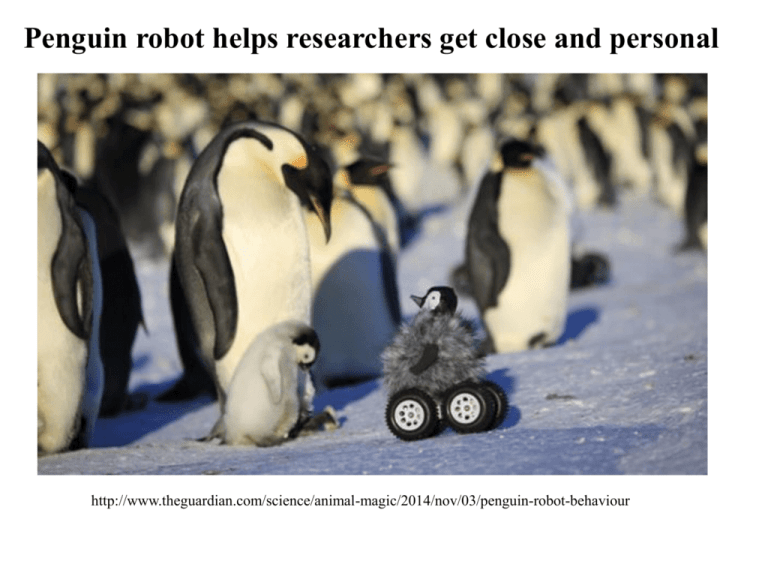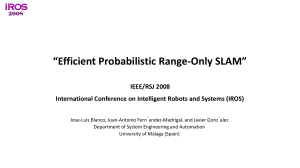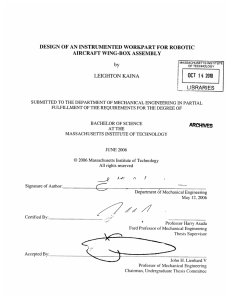Human Factors
advertisement

Penguin robot helps researchers get close and personal http://www.theguardian.com/science/animal-magic/2014/nov/03/penguin-robot-behaviour My robot project is this far A. All done – robot leaves arena with green beacon B. Can find green beacon – but can’t leave arena C. Can find red beacon and turn it off – but can’t find green beacon D. Can find red beacon but can’t turn it off E. Cannot find red beacon Human Factors in Design What are Human Factors (HF)? And why do engineers need to be concerned about them? Human Factors is the application of knowledge about human characteristics to design • Physical ▫ Strength, size, reaction time, endurance, frailty, eyesight, fine motor skills • Social/Emotional/Cultural ▫ User preferences (simplicity, reliability, aesthetics, safety, cost, etc.), culturally-based behaviors (reading, speaking), acceptance • Cognitive ▫ Understanding cause and effect, user interface, interpreting emotions and intentions Man – Machine Interface Human Cognitive Action Interface/Interaction Sensory Machine Display/ Configuration Machine Processing Control Human-System Interface Senses - Vision - Hearing Psychomotor - Hands I N T E R F A C E Output - Display - Sound Input Devices - Buttons US Department of Veteran Affairs Human Factors also acknowledge that humans are fallible.., people make mistakes! So why consider Human Factors? • • • • Improve efficiency Ensure safety* Increase human performance (i.e., productivity) Minimize costs (economic, legal, social) *Especially critical to space/air, nuclear and healthcare industries Human Factors design considerations affect product effectiveness, safety, and ultimately, desirability. Source: FDA Medical Device Use-Safety Example: Healthcare-related technology is rapidly growing You hope Human Factors were considered in the design of this equipment Human Factors (ergonomics) integrates knowledge from multiple fields • • • • • Engineering Psychology Physiology/Kinesiology Biology Anthropology SJSU has a Human Factors program in the Industrial and Systems Engineering Department Source: Integrated Safety Management, Berkeley Lab wikipedia Astronaut interacting with a space system that was designed with human factors. (This image is in the public domain. Source: NASA) Human neural prosthetics include human factors engineering, creating new interface methods. http://nitrolab.engr.wisc.edu/research.php Human Factors should only be considered when designing complex systems? A. True B. False The Kitchen Kitchen layout 1920-1954 Department of Agriculture/National Archives. Gilbreth’s “Kitchen Practical” Design Harris & Ewing/ Smithsonian Institution Archives/Wikimedia Commons Photograph by Theodor Horydczak/Library of Congress Consider how human factors were included in the IDEO shopping cart design. http://www.ideo.com/work/shopping-cart-concept http://www.ideo.com/work/shopping-cart-concept IDEO cart didn’t take off but there were others. In Europe easy to navigate in small markets https://worldofparis.wordpress.com/tag/carrefour/ Physical Domain – Consider human scale Physical Domain – Consider Anthropometric Data – For example reach Source: http://openacademyofknowledge.wikispaces.com/ Source: http://www.mccauslandco.com/ Physical Domain – Consider Developmental Capabilities Physical Domain – Assistive Technology Physical Domain: Consider Effects of Stress Performance level The relationship between stress and performance Area of “optimum” stress High stress Anxiety, panic Low stress Boredom Stress level Yerkes, R. M., & Dodson, J. D. (1908) The relation of strength of stimulus to rapidity of habit-formation. Journal of Comparative Neurology and Psychology, 18, 459-482 Social Domain – Cultural Norms Social/Emotional • Follows Social Conventions ▫ Getting on elevator – wait your turn • Can respond to human signals ▫ Change of voice (e.g. express sympathy when you are tired) ▫ Response to violent behavior Bandit-II used in hospitals Social/Emotional • Match robot personality to that of user Source: Tapus (2008) Social/Emotional • Human but not too human – “uncanny valley” Source: pinktentacle.com Cognitive Domain – What do users perceive? See Woods paper Friendly? Unfriendly? Cognitive Domain – What do users perceive? See Woods paper Can talk? Can’t talk? Cognitive Domain - Compatibility Which would be considered a Human Factor to be addressed? A. B. C. D. E. Limited memory Fatigue Development stage of user Cultural All of the above Cognitive Domain – Sometimes we don’t say what we see …. • Say the color of the words that appear Optillusions.com Ooops! There goes my coffee!!! http://www.baddesigns.com/starbucks.html Remedy(?): An instruction card was placed next to machine http://www.baddesigns.com/starbucks.html Can Opener Conventional can opener Cuts below the rim of the can What’s wrong with the design on the right? http://www.baddesigns.com/canopen.html Attention to which Human Factors in the workplace could help reduce errors? A. B. C. D. E. Avoiding reliance on memory Making things more visible Simplifying processes or procedures Making equipment easy to operate All of the above Designing Across the Lifespan • 1 page (400-500 words) for each member of the team (not a team paper) • Discuss how to modify the design of a companion robot to serve a child or a 65+ adult • Base your design decisions on information from reliable literature (see example in Canvas: Robot Module: Background Reading….) • You will be submitting this in your Lab Discuss some ways you might modify an assistive robot for the two audiences Source: http://www.robaid.com/ https://josefstetter.wordpress.com/2011/04/24/back-to-basics-interview-prepping/








